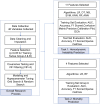Enhancing clinical decision-making in closed pelvic fractures with machine learning models
- PMID: 39652135
- PMCID: PMC12097389
- DOI: 10.17305/bb.2024.10802
Enhancing clinical decision-making in closed pelvic fractures with machine learning models
Abstract
Closed pelvic fractures can lead to severe complications, including hemodynamic instability (HI) and mortality. Accurate prediction of these risks is crucial for effective clinical management. This study aimed to utilize various machine learning (ML) algorithms to predict HI and death in patients with closed pelvic fractures and identify relevant risk factors. The retrospective study included 208 patients diagnosed with pelvic fractures and admitted to Suning Traditional Chinese Medicine Hospital between 2019 and 2023. Among these, 133 cases were identified as closed PFs. Patients with closed fractures were divided into a training set (n = 115) and a test set (n = 18). The training set was further stratified into two groups based on hemodynamic stability: Group A (patients with HI) and Group B (patients with hemodynamic stability). A total of 40 clinical variables were collected, and multiple machine learning algorithms were employed to develop predictive models, including logistic regression (LR), C5.0 Decision Tree (DT), Naive Bayes (NB), support vector machine (SVM), K-nearest neighbors (KNN), random Forest (RF), and artificial neural network (ANN). Additionally, factor analysis was performed to assess the interrelationships between variables. The RF and LR algorithms outperformed traditional methods-such as central venous pressure (CVP) and intra-abdominal pressure (IAP) measurements-in predicting HI. The RF model achieved an average under the ROC (AUC) of 0.92, with an accuracy of 0.86, precision of 0.81, and an F1 score of 0.87. The LR model had an average AUC of 0.82 but shared the same accuracy, precision, and F1 score as the RF model. Key risk factors identified included TILE grade, heart rate (HR), creatinine (CR), white blood cell count (WBC), fibrinogen (FIB), and lactic acid (LAC), with LAC levels >3.7 and an injury severity score (ISS) >13 as significant predictors of HI and mortality. In conclusion, the RF and LR algorithms are effective in predicting HI and mortality risk in patients with closed PFs, enhancing clinical decision-making and improving patient outcomes.
Conflict of interest statement
Conflicts of interest: Authors declare no conflicts of interest.
Figures










Similar articles
-
Interpretable machine learning for predicting isolated basal septal hypertrophy.PLoS One. 2025 Jun 30;20(6):e0325992. doi: 10.1371/journal.pone.0325992. eCollection 2025. PLoS One. 2025. PMID: 40587445 Free PMC article.
-
Supervised Machine Learning Models for Predicting Sepsis-Associated Liver Injury in Patients With Sepsis: Development and Validation Study Based on a Multicenter Cohort Study.J Med Internet Res. 2025 May 26;27:e66733. doi: 10.2196/66733. J Med Internet Res. 2025. PMID: 40418571 Free PMC article.
-
Construction and validation of HBV-ACLF bacterial infection diagnosis model based on machine learning.BMC Infect Dis. 2025 Jul 1;25(1):847. doi: 10.1186/s12879-025-11199-5. BMC Infect Dis. 2025. PMID: 40596896 Free PMC article.
-
The effectiveness and cost-effectiveness of carmustine implants and temozolomide for the treatment of newly diagnosed high-grade glioma: a systematic review and economic evaluation.Health Technol Assess. 2007 Nov;11(45):iii-iv, ix-221. doi: 10.3310/hta11450. Health Technol Assess. 2007. PMID: 17999840
-
The Machine Learning Models in Major Cardiovascular Adverse Events Prediction Based on Coronary Computed Tomography Angiography: Systematic Review.J Med Internet Res. 2025 Jun 13;27:e68872. doi: 10.2196/68872. J Med Internet Res. 2025. PMID: 40513092 Free PMC article.
References
-
- Mandell JC, Khurana B. Musculoskeletal trauma and infection. Magn Reson Imaging Clin N Am. 2022;30(3):441–54. https://doi.org/10.1016/j.mric.2022.04.007. - PubMed
-
- Rondanelli AM, Gómez-Sierra MA, Ossa AA, Hernández RD, Torres M. Damage control in orthopaedical and traumatology. Colomb Med (Cali) 2021;52(2):e4184802. 2021 Jun 30. https://doi.org/10.25100/cm.v52i2.4802. - PMC - PubMed
-
- Graber M, Marino DV, Johnson DE. Anterior hip dislocation. In: StatPearls. Treasure Island (FL): StatPearls Publishing; 2023 Jul 25. - PubMed
-
- Kleweno CP, Scolaro J, Sciadini MF, McAlister I, Shannon SF, Chip Routt ML. Management of pelvic fractures. Instr Course Lect. 2020;69:489–506. PMID: 32017748. - PubMed
-
- Atif M, Hasan O, Baloch N, Umer M. A comprehensive basic understanding of pelvis and acetabular fractures after high-energy trauma with associated injuries: narrative review of targeted literature. J Pak Med Assoc. 2020;70(Suppl_1):S70–75. PMID: 31981340. - PubMed
MeSH terms
LinkOut - more resources
Full Text Sources
Medical
Research Materials
Miscellaneous

